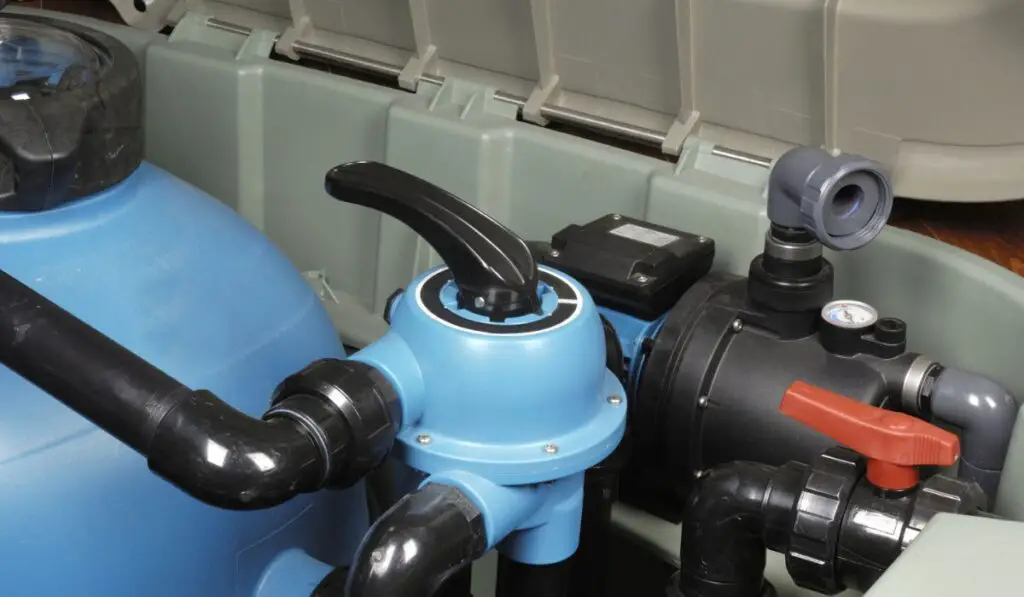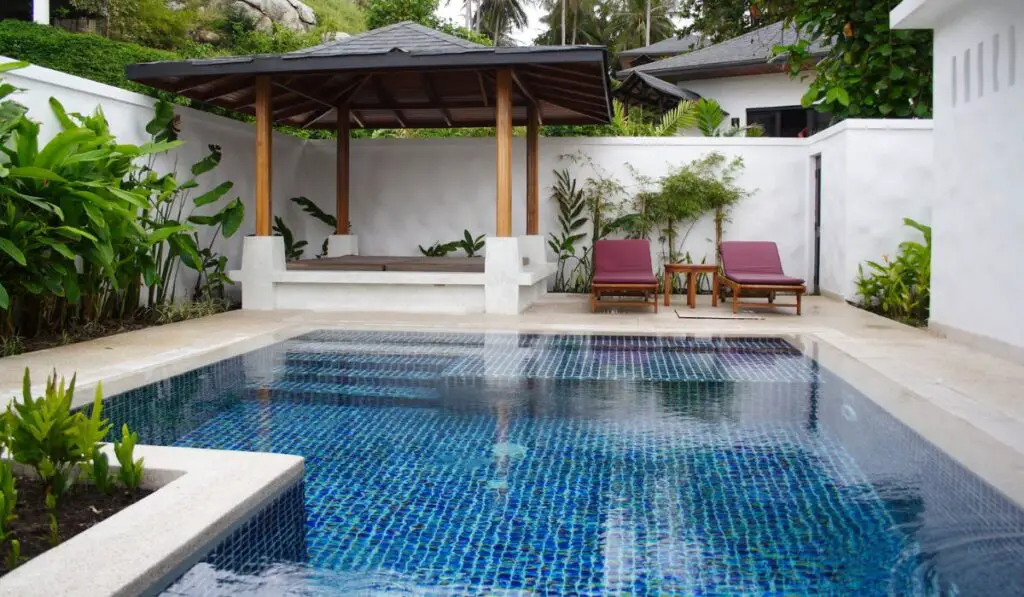Whether you’re a new pool owner or a veteran pool pro, knowing how to close your pool is just as important as knowing when to do it. So, how do you close a pool with a sand filter?
To close a pool with a sand filter, gather all the necessary supplies and equipment. Drain the pool through the filter, and then isolate and drain the filter. Once you’ve prepared your chemicals and drained the pool down to at least below the skimmer, go ahead and install the cover.
Even though closing your pool takes a bit of effort, it doesn’t have to be a huge pain. To be blunt, it’s nothing compared to the amount of work you’ll have to put up with when opening the pool if you don’t close it properly! Let’s take a closer look at the steps so that you can get it right every time.
How Do You Winterize a Sand Filter?

Here’s how you winterize a sand filter in 4 easy steps:
- Put the filter setting to ‘whirlpool‘ or ‘recirculate‘ to bypass the filter tank and send the water through the filter head alone. Blow until you hear or see no more water if you’ve left the plumbing system open.
- Without changing the filter head or blower settings, turn off the blower, then carefully remove the filter pressure gauge and backwash sight glass. If you have an air vent or bleeder valve on your sand filter, open it as well, then turn on the blower once to expel extra water.
- Turn off the blower and tweak the filter head setting to ‘winter.’ If you don’t have this option, push down on the filter handle like you’re going to change the settings but leave it propped up on edge.
For newer filters, leaving the dial valve up on the edge is the same as the ‘winter‘ setting, and it leaves all ports open. Give the blower one last shot to eliminate all residual moisture.
- Remove the plug at the bottom of the filter tank and store it in the pump strainer basket. Leave the sand filter to drain off fully once you’ve removed the plug from the bottom of the tank. This could take a few hours to a couple of days.
How Do You Close a Pool?
Following the correct steps when closing your pool will give you an easy time the next season you open it. Here are the detailed steps for closing a pool:
Step 1: Gather All the Necessary Supplies
Find all chemicals and supplies you’ve used over the years like antifreeze, algaecide, cover weights, and skimmer plugs.
Step 2: Prepare the Filter
Remove the main drain plug of the filter and drain it completely. You can also unthread the filter unions that hook it up to the piping so you can further drain the filter and backwash valve.
Make sure to get air into the filter. This is highly recommended if you have a small filter you can drain and carry to a warm area where it won’t freeze.
Step 3: Blow Out the Lines at the Pool Equipment
Use your shop vacuum or air compressor to blow out the lines and plug them if you can. You’ll probably need a helping hand for this.
Step 4: Prepare Your Pump
Disconnect the drain plugs from your pump and keep them safely in the pump basket. If your pump has unions, disconnect it entirely from the plumbing and turn it upside-down to drain excess water.
Step 5: Prepare the Heater and Additional Equipment
Pull the drain plugs on the front, and the back headers of your heater, then blow out any residual water using an air compressor. If you have other equipment with drain plugs, like a booster pump or an in-line chlorinator, drain them in a similar way.
Step 6: Remove the Return Jet Fittings and Skimmer Baskets
Remove the return jet fittings, skimmer baskets, and weirs — the little flappers that work as a door at the throat of a skimmer.
Step 7: Blow Out Return and Suction Lines
Blow out all the return jet pipes using an air compressor, then put a plug in the fitting under the water when you see the bubbles blowing at full force.
Similarly, blow out the suction lines, then use a Gizzmo-style screw to plug the skimmer when you can see bubbles. To make tight connections, seal the Gizzmo threads with PTFE tape before installing them.
Step 8: Get the Chemicals Ready
Pre-dissolve the shock chemicals and any winterizing products one at a time in a bucket before you add them to the pool water. Make sure all granules are fully absorbed by brushing them thoroughly.
Ensure your chlorine level is over 3 ppm, then test the pool’s pH and total alkalinity with a testing kit (on Amazon). Adjust the pH to normal levels of 7.2 to 7.6 using pH Plus or Minus. Using Alkalinity Plus, maintain the alkalinity level between 80 and 120 ppm.
Step 9: Drain the Pool a Little
Remove some water from the pool to prevent freeze damage and overflow. You should keep the level below the tile border or the bottom edge of the skimmer, whichever is lower. The exact level to which you drain the water depends on the type of cover and pool surface you have.
Please follow the manufacturer’s recommendations because the water supports your cover and the weight of snow or debris that lands on top.
Step 10: Install the Pool Cover
Inspect the cover for rips and tears, ensuring you patch them appropriately using heavy-duty duct tape. Finally, place the cover over the pool.
What Supplies Do You Need To Close a Pool?
The supplies you need to winterize and close your pool will vary slightly depending on your area’s climate, the pool accessories you have, and whether you’ve been maintaining proper water chemistry.
Here’s a list of the supplies you need to close a pool:
- Air compressor
- Algaecide
- A skimmer plate or Gizzmo
- Cyanuric acid (on Amazon)
- Calcium hardness increaser, if necessary
- Metal sequestrant
- Pool vacuum
- Pool brush (on Amazon)
- pH increaser or decreaser (if required)
- Rubber plugs
- Sanitizers like chlorine or bromine
- Shock (on Amazon)
- Telescoping pole
- Tools for removing pool accessories, like ladders
- Water tubes
- Water chemistry test kit or strips
When Should You Close Your Pool?

The best time to close your pool is when the water temperature is consistently below 60℉. Once the temperature drops below 60 degrees, bacteria and algae can’t grow and will remain dormant throughout the winter. This helps with the overall chemistry of your pool water, and it will remain clearer.
While you may want to close the pool based on convenience — like for a vacation — you shouldn’t do so when the weather is still warm. The winter protection chemicals you add will quickly get consumed and won’t last until spring.
How Long Should a Pool Be Closed?
You should close your pool for 6 months during the winter because there isn’t much going on during that time. But after this duration, you must open, run, and manage the pool to ensure it’s safe and ready to use.
The goal is to remove the cover before the heat of the summer sun kicks in, or you’ll have a problem with the massive growth of algae and bacteria.
